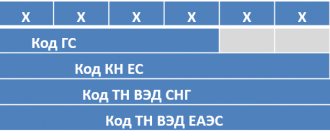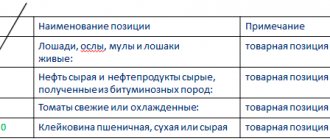Who needs statistics and why?
Customs statistics of foreign trade activities are the official source of information for government agencies that control the volume of imported and exported products by countries and economic entities. It allows you to monitor all processes occurring in the foreign trade market, the rise and fall of prices for certain groups of goods.
To run a successful business, manufacturers also need to know which groups of goods are exported and imported, under what conditions and at what prices. Data analysis allows you to:
- optimize foreign economic activity;
- take it to a new level;
- get the maximum number of clients;
- select the most competitive product groups and leading partners;
- ensure a stable level of profit.
Tasks and goals of TST
Tracking foreign trade transactions is necessary:
- to form a unified trade policy of the state in relation to other countries;
- ensuring security in the sphere of national interests;
- control over dangerous weapons.
The objectives of customs statistics are determined by state regulations and include:
- when analyzing market conditions;
- when preparing reports on the activities of specialized services.
Since 2004, there has been a four-level system for organizing customs statistics:
- the federal level is represented by the Office with the TST Center;
- TS departments in the regions;
- statistical collection departments at each customs office;
- function of collecting primary information at check posts.
Objects of customs statistics include:
- parameters of commodity flows in quantitative and price characteristics;
- geographical orientation of commodity flows;
- studying a number of special indicators.
The goals of customs statistics are to provide government agencies with complete information in the field of foreign trade. Taking into account the goal, two broad directions are distinguished. Objectives of customs statistics of foreign trade:
- preparation of reliable information;
- analysis of the main trends and structure of commodity flows depending on the state of the macroeconomy;
- preparation of analytical data for the development of methods for regulating foreign trade activities.
Special customs statistics deals with the following areas:
- customs payments;
- movement of transport and citizens across the border;
- features of declaration;
- currency control problems.
Analysis of the received information allows:
- optimize the structure of customs services;
- simplify the procedure;
- strengthen counteraction to violations.
What is a statistical declaration
If a Russian person moves cargo across the border of the Russian Federation, he is obliged to take into account the rules established by Russian customs legislation. These rules vary and depend, in particular, on which country the person is trading with; customs statistical reporting is mandatory when trading with states that are members of the Eurasian Economic Union:
- Republic of Belarus;
- Armenia;
- Kazakhstan;
- Kyrgyzstan.
Statistical reporting is a document that the Federal Customs Service will require when moving items within the EAEU; the form for this reporting and the procedure for filling it out are approved by Government Decree No. 1329 of December 7, 2015.
The principle of a unified methodology
The customs statistics method corresponds to the unified methodology of the Customs Union. It mainly depends on the accounting principle: in a general or special system. The first option is that goods are registered while crossing the state border. The second option is when passing the customs border.
Maintaining customs statistics of foreign trade takes into account the UN regulatory framework and ensures comparability of indicators with data from the international accounting system. Import/export of goods are accounted for according to the general system. When determining the quantitative parameters of a product, net weight is used, which is more convenient to use.
Customs statistics use the gross weight at the time of shipment of goods to indicate the total volume of shipments. Regarding cost indicators:
- export goods are accounted for at FOB prices;
- Imported products are registered at CIF prices.
Determination of cost
Customs value statistics are of particular importance, as they are the basis for calculating the tax base. The customs agreement of the EAEU countries establishes the definition of an indicator based on the value of the transaction with imported goods. This is how more than 90% of export-import transactions in world practice are assessed. Customs duties statistics characterize the state of fiscal activity of the Customs Union and serve as the basis for:
- for planning reserves for contributions to the budget;
- developing a strategy for regulating foreign trade turnover.
In 2021, the budget received 4.4 trillion. rub. customs payments. Customs statistics show that the share of exports amounted to 2.09 trillion. rub. The share of imports is 2.31 trillion. rub. The change in the payment structure is due to:
- with a decrease in oil exports in monetary terms;
- with the transfer of the tax burden on oil from the sphere of export duties on its production.
Database
The customs statistics base is primarily formed from cargo declarations issued for goods. The customs declaration records:
- manufacturer, sender, recipient of goods;
- cost of the consignment;
- quantity or volume of cargo;
- date of preparation of the declaration.
Customs statistics of the Customs Declaration contains data on all foreign trade operations that passed through the Federal Customs Service:
- with details of organizations from the Rosstat database;
- extended product description;
- data by country.
Customs statistics data also contain the nomenclature code - TN VED. It is used for a unified classification of goods by participants in foreign trade transactions in the EAEU countries. The presence of a HS code simplifies the calculation of customs duties.
+7
Customs statistics 1996-2021 of Russia and the CIS countries, analysis of foreign trade activities, customs database, railway transportation database
leading supplier of up-to-date information on customs statistics in Russia and the CIS countries!
We have a complete, regularly updated customs database (database of customs declarations - CCD) for all export-import operations of Russian companies for 1996 - the current date of 2021 (data for ALL customs posts of the Russian Federation).
It contains complete declarations of all participants in Russian foreign economic activity. We offer online access to a complete database of customs statistics or a selection from the foreign economic activity database of Russia and the CIS countries.
The advantage of an online foreign trade database is the ability to make a request at any time, from any computer, from anywhere in the world using any parameter or combination thereof (for example: customs post code and time interval, name of the cargo importer and country of origin, trademark and article number) and receive a ready-made analytical report or source data from customs declarations in a matter of seconds.
Information on customs statistics of the Russian Federation will help you quickly make a decision on the current values of passing prices, avoid CTS, select the correct HS code, receive an analytical report in a matter of seconds and save it in Excel or Word. The search is possible by any criterion or combination: product code according to the Commodity Nomenclature of Foreign Economic Activity, INN, product name, country of origin, etc. Updates occur weekly, so you will always have the latest information.
All you have to do is choose one of three standard approaches for analyzing customs statistics:
- Full access to the latest and most complete customs database online. Access is provided through a convenient shell program designed specifically for searching and analyzing customs statistics data. The search is possible by any criterion or a combination of them: product code according to the Commodity Nomenclature of Foreign Economic Activity, INN of a participant in foreign economic activity, name of the product, country of origin, etc. For ease of data analysis, it is possible to create about 60 different statistical reports with a visual display of supply dynamics. A sample with source data, a statistical report and any information found can be saved in Excel or Word with one click.
- Selection from the foreign trade database according to any of your requests (HS codes, manufacturer, importer, etc.). The format to choose from is excel or the search and analytical shell of the Customs Information System.
- Personal analytical report on foreign trade activities of the product or brand you are interested in - “manual” data processing, statistical calculations, conclusions of a marketing analyst, forecasts and analysis.
The data contains complete, reliable and detailed information about the recipient and sender of the cargo, the CCD number (cargo customs declaration), the product (including an extended description), the goods code according to the Commodity Classification of Foreign Economic Activity, quantity, value, date of release of the cargo, banks servicing the transaction, adjustment of customs value, customs terminal, etc. - in total more than 160 fields of the customs declaration. All fields of each customs declaration in our foreign trade database are presented in full, without abbreviations , so you can obtain detailed information about each customs declaration and foreign economic contract.
Customs statistics are a particularly important tool for monitoring the activities of competitors, analyzing the situation in markets and reflecting the dynamics of foreign trade turnover, volumes of imports and exports in physical and value terms, and changes in the geographic focus of export-import operations.
The DT database is equipped with our development - the software shell “Information and analytical system “CUSTOMS” , which allows you to quickly obtain clear and convenient reports on customs statistics, build graphs and diagrams that clearly display the situation on commodity markets, quickly find declarations by any criteria and upload a selection to Excel. IAS “Customs” is designed to process information from the customs database, analyze the distribution of cargo flows and identify trends in foreign trade activities.
Customs statistics data make it possible to study in detail the situation on the foreign economic market and obtain reliable data on importers and exporters, foreign trade statistics - goods and volumes, prices and dynamics, import and export countries, transport and working conditions, and analyze the foreign trade activities of any Russian enterprise.
Using the foreign trade database from Expert-VED you can:
- Using the customs database, assess the potential of any Russian-made product - leading importing-exporting countries, quantity, weight, monetary equivalent, supply dynamics
- Assess the activities of all participants in foreign trade activities: “who is who”, work experience, product assortments, supply dynamics, export (import) volumes, countries and buying companies, pricing policy, “favorite” customs, the existing market balance of forces, main partners and players
- Identify new and promising market niches
- Determine optimal working conditions with foreign counterparties
- Develop strategy and tactics of behavior in selected market segments
Doubt the completeness and reliability? — we will send your data for free - the best way to ensure the quality and relevance of our data
The customs database from Expert-VED is the most complete and regularly updated information product based on customs data, significantly ahead of similar databases on foreign economic activity, both in completeness and reliability, as well as in ease of operation and ease of information analysis!
Using the foreign trade database
The customs statistics database allows you to conduct market research:
- according to the seasonal structure of commodity flows;
- the volume of exports and imports for a given product group;
- dynamics and conditions of supplies;
- price fluctuations;
- transport orientation.
Customs statistics on foreign trade activities help develop a foreign trade strategy. It tracks information:
- about competing companies operating in the foreign market and their counterparties;
- about banks participating in financial transactions;
- about goods that are in greatest demand.
The customs statistics website provides free access to information that is required when analyzing the structure of exports/imports. Data can be viewed for the last three years. Information on the constituent entities of the Russian Federation is located on regional websites.
Where official customs statistics are published free of charge
Despite the fact that customs statistics are of obvious commercial interest, information on the structure of exports and imports can be found in the public domain on the official website of the Federal Customs Service. This service will be of particular interest to marketers and managers involved in the generation of statistics and analysis of foreign trade activities.
The statistics of interest can be found in the “Data Analysis” section; you need to select the necessary filters and click on the “Show result” button. A tabular form will appear on the screen, in which the following information is reflected in separate columns:
- HS Code;
- Importing or exporting country;
- The period for which the statistical data was selected;
- Statistical cost in dollars (in thousands or millions of dollars - depending on the selected filter);
- Volume in kilograms or tons (for certain products the quantity in pieces may be indicated);
- Subject of the Russian Federation is the region in which the consignee or consignor is located.
The service on the official website of customs statistics also allows you to download data into MS Excel.
The customs statistics website has detailed instructions for users with a step-by-step description of how the system works.
Of course, processing, structuring, grouping and bringing statistical data into a “readable” form will take a lot of time. It is sometimes easier for interested parties to order a ready-made report for specific requests than to personally understand all the manipulations with tabular forms.
Paid services
Analysis of customs statistics plays an important role in the activities of companies participating in foreign trade. However, understanding the data structure is quite difficult. It’s easier to order a paid one for drawing up a report for the required period.
Similar services are provided. The customs declaration database will be provided with a guarantee of completeness and reliability of the information. Advantages of cooperation with the company:
- customs import/export statistics are updated every week;
- reports provide a detailed overview with expanded data;
- the level of complexity of the order does not matter;
- reasonable prices.
To assess the quality of work, you can order a free report on your own organization. Statistics on customs services conditionally divide them into public and private. The first include:
- maintenance of registers of foreign trade participants;
- information and consulting services;
- questions about making preliminary decisions;
- customs agent services.
Private services include:
- consulting;
- warehousing and storage of cargo;
- certification issues.
When should I fill out and submit?
The deadline for submitting the declaration is no later than the eighth working day of the month following the month of shipment or receipt of goods. Here is the schedule for submitting statistical forms to customs authorities for 2020:
| Month of shipment/receipt | Deadline for submission |
| December 2019 | 20.01.2020 |
| January 2020 | 12.02.2020 |
| February | 12.03.2020 |
| March | 10.04.2020 |
| April | 18.05.2020 |
| May | 10.06.2020 |
| June | 10.07.2020 |
| July | 12.08.2020 |
| August | 10.09.2020 |
| September | 12.10.2020 |
| October | 12.11.2020 |
| November | 10.12.2020 |
| December | 20.01.2021 |
The reporting person has the right to fill out the form immediately after shipment or receipt of goods - it is not necessary to wait for the delivery date. If several deliveries under one contract in the reporting period were moved from one sender to one recipient, several statistical reports for each shipment or general statistics on the results of the execution of the agreement are allowed.
Features of trade in the EAEU
The formation of customs statistics should take place according to the principle of mirror reflection. The volume of imports and exports should be equal. However, there is a principle of mutual trade, which concerns trade transactions carried out between the countries of the EAEU.
Customs statistics of mutual trade are maintained separately by the authorized bodies of the EAEU countries. In Russia, registration of mutual trade transactions is carried out by Rosstat. The collected information according to the agreed list of indicators is transferred to the EAEU Statistics Department.
Control system
An important part of international trade is customs control. Statistics show the effectiveness of the new accounting system. The system is based on the principle of risk management. All commercial products imported into the country are considered to be under customs control for three years. During January-March 2021, 1025 inspections were carried out. The budget received additional accruals in the amount of 1.4 billion rubles.
Customs crime statistics deals with the analysis and prevention of crimes. In the first three months of 2021, the following was revealed:
- administrative offenses – 1399;
- criminal – 99.
The creation of a unified information system of the Federal Tax Service and the Federal Customs Service makes it possible to track the movement of goods from the moment they cross the border.
In the 1st quarter of 2021, RUB 266 million was recovered. Federal customs statistics notes:
- acceleration of the declaration procedure;
- reducing the risk of importing counterfeit products into the country;
- unscrupulous participants in foreign trade activities begin to leave the market.
How to fill it out correctly
The declaration for the movement of goods is filled out according to a unified form. It was approved in Appendix No. 1 of the RF PP No. 1329 dated December 7, 2015. All positions are filled in according to the rules for maintaining statistics from Resolution No. 1329.
There are two ways to fill:
- online - customs statistics in the personal account of a foreign trade participant;
- electronic - entering information into a unified declaration form on a PC.
To work in your personal account, you will need an electronic signature and confirmation of the organization.
If you fill out a declaration through your personal account, enter the information into the online form, check the information is correct, sign the document with an electronic signature and send it to the customs office.
But here are the rules for filling out paper documents (Appendix No. 2 to RF PP No. 1329 dated December 7, 2015):
- Prepare a declaration using a unified form.
- Indicate the reason: dispatch or receipt of products in the reporting month.
- Review and save the information.
- Wait for the system number.
- Print out the customs statistical form and have it signed by your manager. Stamp this.
Indicators for 2021
The statistics of the Customs Union for 8 months amounted to 34 billion, which is 27.5% more than in 2021. Of them:
- Armenia – 317.4 million
- Belarus – 8.8 billion.
- Kazakhstan – 3.2 billion.
- Kyrgyzstan – 384.3 million.
- Russia – 21.3 billion dollars.
Statistics of mutual trade of the Customs Union in percentage terms:
| A country | Export | Import |
| Armenia | 0,9% | 2,3% |
| Belarus | 25,8% | 36,4% |
| Kazakhstan | 9,7% | 22,7% |
| Kyrgyzstan | 1,1% | 3,4% |
| Russia | 62,5% | 35,2% |
Customs statistics of the EAEU show a slight increase in the proportions of mutual trade in 2017. Share of gross indicators in the total volume of foreign trade:
| EAEU countries | The share of trade with third countries in the total volume of foreign exchange. trade (%) | The share of mutual trade in the total volume of foreign trade. trade (%) |
| EAEU | 85,4 | 14,6 |
| Armenia | 72 | 28 |
| Belarus | 47,2 | 52,8 |
| Kazakhstan | 77,7 | 22,3 |
| Kyrgyzstan | 61 | 39 |
| Russia | 91,1 | 0,9 |
Structure of mutual trade in the EAEU:
- mineral raw materials – 27.9%;
- machinery and equipment – 17.7%;
- agricultural raw materials and products – 15.4%;
- metal products – 13.2%.
Statistics from customs authorities indicate that the bulk of supplies of mineral products come from Russia. It accounts for more than 84%. It also leads in sales on the EAEU market:
- machinery and equipment – 55%;
- chemical industry products – 63.5%;
- metals and products made from them – 61.4%.
Customs service statistics demonstrate a change in the dynamics of economic development in the EAEU countries. During the period from January to September 2017, the overall GDP increased by 1.9%. By country:
- Armenia – by 5%;
- Belarus – by 1,%;
- Kazakhstan – by 4.3%;
- Kyrgyzstan – by 5%;
- RF – by 1.6%.
When to fill out the declaration
It is necessary to fill out a statistical report to the customs office of the customs union whenever objects are moved across the state border of the Russian Federation within the union, including:
- temporarily for a period of more than 1 year;
- imported as contributions to authorized funds;
- as part of the provision of humanitarian or technical assistance;
- under barter or consignment agreements;
- for processing;
- under a leasing agreement for more than 1 year.
In some cases, the customs statistical form is not filled out, for example, if the goods:
- moving in transit;
- moved by individuals for personal needs;
- are moved to or removed from the Baikonur complex;
- are imported or exported for a period of less than 1 year;
- are exhibition pieces.
A complete list of cases when a customs report for export or import is not required is indicated in clause 3 of the rules for maintaining statistics, approved by Government Decree No. 1329 of 12/07/2015.
Belarus in the EAEU market
Belarus is most oriented towards the common market. Customs statistics of the Republic of Belarus show that the growth rate of trade volumes (export/import) for 9 months of 2021 is approximately 123.2% and 124.0%. The total volume is dominated by trade relations with Russia:
- exports increased by 21%;
- imports – by 23.8%.
Customs statistics of the Republic of Belarus in 2021 demonstrate an improvement in the export of non-resource products to the common market. Volume increased by 24.4% in value terms. The increase in export volumes corrected the situation in industrial production. Its figures increased by 6.1%.
Customs statistics of Belarus show that the bulk of mutual trade is provided by large industrial enterprises. They account for 65% of exports and 63% of imports.
Indicators of the Russian Federation
Customs statistics of the Russian Federation characterize the mutual trade intensity index as the highest among the EAEU members. Over the first 9 months of 2021, the volume of foreign trade transactions on the market increased by 27.5%. Customs statistics of the Russian Federation notes among its main trading partners:
- Belarus – 56.4% of exports and 68.8% of imports.
- Kazakhstan – 36.2% of exports and 27.5% of imports.
Russian customs statistics show an increase in mutual trade indicators:
- Belarus – by 23.3%;
- Kazakhstan – by 35.6%;
- Armenia – by 26.9%;
- Kyrgyzstan – 31.7%.
The total trade turnover on the single market in January-September 2021 amounted to $37,581.6 million. Foreign trade customs statistics increased by 25.1%.
The bulk of exports in 2021 were goods of the fuel and energy group. Their volume has increased:
- in monetary terms – by 27.1%;
- in physical terms – by 1.7%.
New reporting
At the end of January 2021, changes to the Labor Code of the Russian Federation came into force. Now each participant in foreign trade activities is required to submit a new reporting form with the parameters of the movement of goods to the customs statistics department.
For failure to comply with the deadlines and conditions for submitting reporting documentation, violators will face a fine. The amount of the penalty for organizations is 20–50 thousand rubles. The amount doubles for repeated violations.
The reporting form can be filled out on the official website of the department - customs.ru. The user needs to click on the “Customs statistics – personal account” tab immediately after registration. You have 8 working days of the next month to submit the document. There is no need to document these numbers.
Customs statistics of the Customs Union are formed on the basis of regular reporting indicators received from market participants.
Who fills out the declaration
The circle of persons required to submit a report to customs statistics is outlined in Art. 278 of Federal Law No. 289-FZ of August 3, 2018. This is a Russian person (organization or individual entrepreneur) who has entered into a transaction, in pursuance of which an item is moved across the state border of Russia within the EAEU.
If there was no such transaction, but the movement of the object took place, the statistical form for recording the movement of goods of the customs union is submitted by the person who has the rights to use, own or dispose of the moved object.








